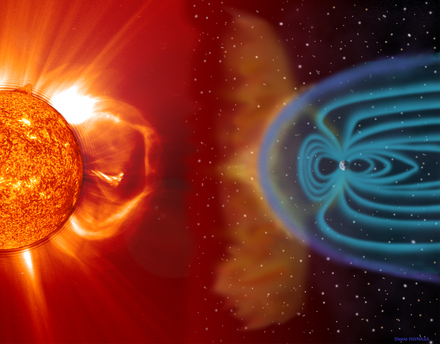Flickering Ghosts
Why is the sky alight?
There have been accounts of what are known as auroras – the eerie reddish and greenish flickering of light in the night sky – for the past 2000 years. The Vikings interpreted the luminous effect as being the shimmer of moonlight on the armor of the ghostly Valkyries as they rode across the sky. But why do auroras occur?
 © NASA/ESA
|
The schematic diagram shows how the solar wind meets the Earth's magnetic field and partially enters the Earth's atmosphere. The shower of particles there causes oxygen and nitrogen to glow.
Astronomy provides us with a scientific explanation for the 'fire in the sky': auroras are created when the solar wind meets the Earth's atmosphere. Solar wind is the name given to the stream of electrically charged particles (for example electrons and protons) that the Sun radiates into space. However, Earth is not completely defenseless against this solar bombardment – its magnetic field shields the Earth’s surface from the majority of the high-energy particles.
The solar wind causes the Earth's sky to light up.
However, if the solar wind is especially strong the particles can penetrate our atmosphere, in particular in the polar regions, where the magnetic field meets the Earth's surface at right angles. The shower of particles there causes air molecules to glow: highly excited oxygen atoms at a height of around 60 miles emit green light and red light originates from oxygen atoms at a height of around 120 miles. Very large amounts of energy are necessary to excite nitrogen atoms, which then emit light that is violet to blue in color.
In mid-latitude regions, including most of Europe, auroras are unusual events. They usually have a red color here, as only rarely can the solar wind penetrate more deeply inside the atmosphere.
German Aerospace Center
The solar wind causes the Earth's sky to light up.
However, if the solar wind is especially strong the particles can penetrate our atmosphere, in particular in the polar regions, where the magnetic field meets the Earth's surface at right angles. The shower of particles there causes air molecules to glow: highly excited oxygen atoms at a height of around 60 miles emit green light and red light originates from oxygen atoms at a height of around 120 miles. Very large amounts of energy are necessary to excite nitrogen atoms, which then emit light that is violet to blue in color.
In mid-latitude regions, including most of Europe, auroras are unusual events. They usually have a red color here, as only rarely can the solar wind penetrate more deeply inside the atmosphere.
German Aerospace Center
Flickering Ghosts
Why is the sky alight?
There have been accounts of what are known as auroras – the eerie reddish and greenish flickering of light in the night sky – for the past 2000 years. The Vikings interpreted the luminous effect as being the shimmer of moonlight on the armor of the ghostly Valkyries as they rode across the sky. But why do auroras occur?
 © NASA/ESA
|
The schematic diagram shows how the solar wind meets the Earth's magnetic field and partially enters the Earth's atmosphere. The shower of particles there causes oxygen and nitrogen to glow.
Astronomy provides us with a scientific explanation for the 'fire in the sky': auroras are created when the solar wind meets the Earth's atmosphere. Solar wind is the name given to the stream of electrically charged particles (for example electrons and protons) that the Sun radiates into space. However, Earth is not completely defenseless against this solar bombardment – its magnetic field shields the Earth’s surface from the majority of the high-energy particles.
The solar wind causes the Earth's sky to light up.
However, if the solar wind is especially strong the particles can penetrate our atmosphere, in particular in the polar regions, where the magnetic field meets the Earth's surface at right angles. The shower of particles there causes air molecules to glow: highly excited oxygen atoms at a height of around 60 miles emit green light and red light originates from oxygen atoms at a height of around 120 miles. Very large amounts of energy are necessary to excite nitrogen atoms, which then emit light that is violet to blue in color.
In mid-latitude regions, including most of Europe, auroras are unusual events. They usually have a red color here, as only rarely can the solar wind penetrate more deeply inside the atmosphere.
German Aerospace Center
The solar wind causes the Earth's sky to light up.
However, if the solar wind is especially strong the particles can penetrate our atmosphere, in particular in the polar regions, where the magnetic field meets the Earth's surface at right angles. The shower of particles there causes air molecules to glow: highly excited oxygen atoms at a height of around 60 miles emit green light and red light originates from oxygen atoms at a height of around 120 miles. Very large amounts of energy are necessary to excite nitrogen atoms, which then emit light that is violet to blue in color.
In mid-latitude regions, including most of Europe, auroras are unusual events. They usually have a red color here, as only rarely can the solar wind penetrate more deeply inside the atmosphere.
German Aerospace Center





